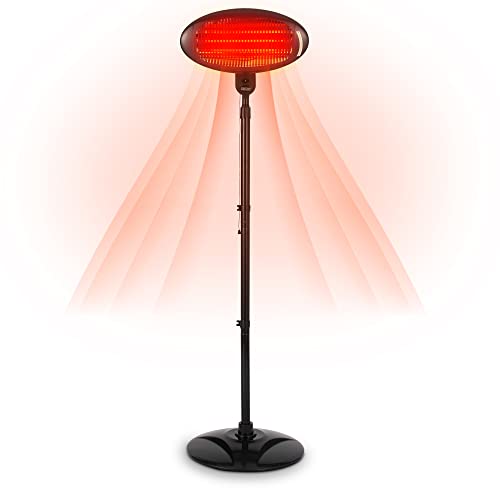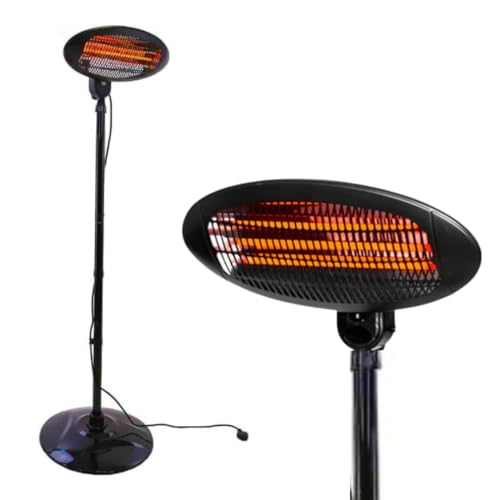A Step-By-Step Guide To Natural Gas Gas Patio Heater From Beginning To…
페이지 정보
작성자 Thurman McEwan 작성일 25-02-18 22:28 조회 8회 댓글 0건본문
 Natural Gas Patio Heater
Natural Gas Patio Heater A natural gas patio heater is an excellent way to keep outdoor spaces warm. Its primary benefit is that it can be connected to existing natural gas lines (NG) which means you won't need to worry about refilling propane tanks.
A natural gas patio heater is an excellent way to keep outdoor spaces warm. Its primary benefit is that it can be connected to existing natural gas lines (NG) which means you won't need to worry about refilling propane tanks.There are a few aspects to consider before choosing one. This article will examine the different choices, including heat output and safety, in addition to the installation.
Cost
You can relax in your outdoor space well into the evening by installing a natural-gas patio heater. These heaters are available in a variety of sizes and can be mounted on walls freestanding or affixed to posts. The best model will include features that will make using your patio more secure and less hassle. There are models that have an anti-slant feature which will turn off the burner whenever it tilts more than 47 degrees. Some models are made from durable materials like aluminum and stainless steel for durability and resistance to corrosion.
They can be powered by propane, electricity or natural black gas patio heater and produce up to 46,000 British Thermal Units (BTUs). Electric models are plugged into 120-volt outlets that are the easiest to set up and use but they don't provide heat as well as natural gas or propane models.
Propane patio heaters look like umbrellas and have hollow bases that can hold 20-pound liquid tanks of propane similar to the ones used in gas grills. The tanks are less expensive than the fuel used for an indoor space heater, however they require refills frequently and they're not able to be moved as easily. There are smaller propane heaters for tables designed to be placed on top of tabletops and use 1-pound propane tanks.
The cost of a natural gas patio heater is based on its dimensions and features including an automatic shut-off, wheels for effortless mobility, a quick ignition and a remote with multiple settings. You can pick from a variety of finishes to match your outdoor decor, including the hammered brass, resin wicker and decorative stone facing.
Natural-gas and electric patio heaters require a professional installation. They aren't movable easily, unlike propane and gas versions. However, they look more durable and function as well as an indoor space heater. You can even get one with a stylish design that is able to be plugged into gas lines with a rigid structure to add a fashionable touch. However, the price of a natural gas patio heater is usually higher than those that run on propane or electricity.
Heat Output
When looking for a natural gas patio heater, pay particular focus on the power output. The amount of BTUs reflects the warmth that your guests will feel and also how long it will keep your patio and balcony warm. The larger the space you can heat, the greater the BTUs.
If your outdoor space is covered or open and sunny, gas patio heaters can help you comfortably enjoy your outdoor space all year long. The majority of models are adjustable and run on propane or natural gas. They can be hung on the ceiling or wall or stand on their own. If floor space is limited, choose a portable natural gas patio heater that has wheels that makes use of readily available propane tanks to provide power to the burner. Look for features such as a gas shutoff to prevent leaks in the event of a fire going out or an anti-tilt feature that shuts off the fuel supply automatically when the unit is tilted more than 47 degrees.
The most efficient natural gas patio heaters deliver plenty of warmth and don't take up too much room on a deck or in your backyard. Large free-standing models that resemble floor lamps provide radiant heat across larger areas, and have a sturdy metal construction. Tabletop models with smaller footprints work well in intimate dining areas. Models that run on propane or natural gas are available in a variety of attractive finishes.
You can also find natural gas and propane patio heaters with hammered bronze resin wicker, decorative stone faces for an elegant look. Other features to look out for include a push-button ignition system that shuts off the safety valve if the unit goes over, and natural Gas patio heater rotary dial control that allows you to easily adjust and set the flame. Some of the top propane patio heaters are made with stainless steel to ensure durability and strength, while others are constructed from aluminum to make them lighter in weight.
Safety
Gas patio heaters can be a great method to extend your time outside. They are available in a variety of styles, from freestanding models that include a propane tank to those that connect to your home's natural gas gas patio heater gas line. The type of heater you choose will depend on your budget and the amount you wish to heat.
Propane-powered heaters are typically an upright, pole or shield that has an reflector or shield. The base holds a 20-pound propane tank (LP). These heaters have a wide range of power outputs between 41,000 BTU's and more than 100,000. These heaters have security features like an automatic shut-off valve and an electronic lighter to enable easy ignition. They also come with a tip-over button that automatically turns off the flow of gas if the unit tip over.
Portable LP gas heaters for patios should only be used outside on hard, flat non-combustible surfaces. They should be kept at a minimum of three feet from any combustible object and at a minimum of 12 inches away from any object that could catch fire, such as fences and trees. The fuel cylinder must always be stored outside and at a minimum three feet away from building, stairways, windows and doors. If you use a propane patio heater, check the connection points and hose regularly for leaks. You can test these connections by using a soapy water solution. Check for the UL or CSA mark on propane patio heaters to ensure it is in compliance with the safety standards of the nation.
A natural gas patio heater is connected to your home's gas patio heater outdoor line. It has an increased BTU rating when than propane units. It may be more expensive to run however it's safer and doesn't need the replacement of propane tanks. These units are ideal for patios in restaurants, residential patios, and common areas in condominium and apartment buildings.
No matter what style of patio heaters you pick be sure that they are approved for indoor use or outdoor use. If natural gas or propane patio heaters are used in a closed area, they can emit deadly carbon monoxide. Electric patio heaters on the contrary, don't release any pollutant and can be used in a closed area.
Installation
Natural gas fired patio heaters patio heaters are connected to the gas line in your home. They don't require a propane tank, like other kinds of outdoor heating. This makes them an easier and safer option than traditional propane heaters. In addition, they don't release the same amount of smoke as propane heaters emit. However, they will require professional installation and come at a a higher cost than propane heaters do.
They are a common addition to both commercial and residential properties and can make your patio comfortable even when the temperatures drop below freezing. These heaters are very safe to use as they do not emit heat from the surface of the heater, instead, they radiate heat from the inside of the hood that is silvered. These heaters are very energy efficient since they don't consume lots of energy.
Patio heaters can either be freestanding or wall-mounted. When wall-mounted, they should be mounted at least 8 feet above the ground to ensure that people are not in the path of radiant heat. Freestanding heaters require an absolute clearance of 14 feet to keep out combustible materials from the area.
These heaters have built-in safety features that safeguard people and their property in the event of malfunction. The majority of heaters have an off valve for tilt that will stop the heater from consuming fuel or electricity if it accidentally slides or tilts. They also have sensors that detect the presence of flame to prevent accidental ignition.
In order to ensure that the gas heaters are safe to use in the home, a licensed plumber should be hired to install them. These professionals should be familiar with state and local plumbing and heating codes to ensure that the gas lines are correctly sized for the heaters. They should also be trained to examine gas appliances for leaks.
Other expenses may be incurred in addition to the labor and materials costs associated with the gas patio heater install. This includes removing, replacing, or repairing any damaged structures or finishes. These expenses include framing and surface finishes as well as plumbing systems. Other possible expenses could include the process of bringing existing systems in line with current building codes. These costs should be included in the overall estimate for the job.
- 이전글Who Is Responsible For An Buy A Taxi License Online Without Exams Budget? 12 Ways To Spend Your Money
- 다음글3 Of The Punniest Deepseek Chatgpt Puns Yow will discover
댓글목록
등록된 댓글이 없습니다.


